Mixed Convection Flow of Water Conveying Graphene Oxide Nanoparticles over a Vertical Plate Experiencing the Impacts of Thermal Radiation
Abstract
:1. Introduction
2. Mathematical Formulation
3. Stability Analysis
4. Research Methodology and Validation
5. Interpretation of the Results
6. Conclusions
- Upper and lower solution branches in the given research model existed for particular domains of the mixed convection parameter, with impacts from several parameters.
- For higher values of , the dimensionless velocity profile in both directions increased for the UBS and decreased for the LBS.
- With a larger consequential value for the radiation parameter and the nanoparticle volume fraction , the temperature distribution profile was increased in both solution branches.
- The magnitude of the critical values increased with and shrank for the larger values of .
- The skin friction coefficients in both directions and the rate of heat transfer were augmented with larger values of and .
- The stability analysis revealed that the UB solution was stable and physically acceptable while the LB solution was not physically stable.
Author Contributions
Funding
Data Availability Statement
Conflicts of Interest
Nomenclature
| Reynolds ratio or material parameter | |
| Arbitrary constants | |
| Shear stress along the x direction | |
| Shear stress along the y direction | |
| Nodal/saddle indicative parameter | |
| Specific heat at constant pressure (J/Kg·K) | |
| Dimensionless velocity along the x direction | |
| Acceleration due to gravity (m/s2) | |
| Dimensionless velocity along the y direction | |
| Thermal conductivity (W/(m·K)) | |
| Mean absorption coefficient (1/m) | |
| Characteristic length (m) | |
| Local Nusselt number | |
| Prandtl number | |
| Radiative heat flux | |
| Radiation parameter | |
| Local Reynolds numbers | |
| Temperature of the fluid (K) | |
| Reference temperature (K) | |
| Variable surface temperature (K) | |
| Constant ambient temperature (K) | |
| Time (s) | |
| Velocity components along the x, y, and z directions (m/s) | |
| Free-stream velocities along the x, y, and z directions (m/s) | |
| Cartesian coordinates (m) | |
| Greek symbols | |
| Thermal expansion coefficient | |
| Eigenvalue parameter | |
| Pseudo-similarity variable | |
| Dimensionless temperature | |
| λ | Buoyancy or mixed convection parameter |
| Absolute viscosity (N·s/m2) | |
| Kinematic viscosity (m2/s) | |
| Density (kg/m3) | |
| Stefan–Boltzmann constant (W/(m2·K4)) | |
| Dimensionless time variable | |
| Solid volume fraction of nanoparticles | |
| Acronyms | |
| BAF | Buoyancy-assisting flow |
| BCs | Boundary conditions |
| BOF | Buoyancy-opposing flow |
| bvp4c | Boundary value problem of the fourth-order |
| GO | Graphene oxide |
| ICs | Initial conditions |
| LBS | Lower branch solution |
| MHD | Magneto-hydrodynamics |
| NSP | Nodal stagnation point |
| ODEs | Ordinary differential equations |
| PDEs | Partial differential equations |
| SP | Stagnation point |
| SSP | Saddle stagnation point |
| 2D | Two-dimensional |
| 3D | Three-dimensional |
| UBS | Upper branch solution |
| Subscripts | |
| Base fluid | |
| Far-field condition | |
| Hybrid nanofluid | |
| Solid nanoparticles | |
| Wall boundary condition | |
| Superscript | |
| ′ | Derivative with respect to |
References
- Choi, S.U.S.; Eastman, J.A. Enhancing Thermal Conductivity of Fluids with Nanoparticles; Technical Report; Argonne National Lab.: Chicago, IL, USA, 1995. [Google Scholar]
- Ellahi, R.; Zeeshan, A.; Vafai, K.; Rahman, H.U. Series solutions for magnetohydrodynamic flow of non-Newtonian nanofluid and heat transfer in coaxial porous cylinder with slip conditions. Proc. Inst. Mech. Eng. Part N J. Nanoeng. Nanosyst. 2011, 225, 123–132. [Google Scholar] [CrossRef]
- Rosmila, A.B.; Kandasamy, R.; Muhaimin, I. Lie symmetry group transformation for MHD natural convection flow of nanofluid over linearly porous stretching sheet in presence of thermal stratification. Appl. Math. Mech. 2012, 33, 593–604. [Google Scholar] [CrossRef]
- Sheikholeslami, M.; Hatami, M.; Ganji, D.D. Analytical investigation of MHD nanofluid flow in a semi-porous channel. Powder Technol. 2013, 246, 327–336. [Google Scholar] [CrossRef]
- Javaherdeh, K.; Ashorynejad, H.R. Magnetic field effects on force convection flow of a nanofluid in a channel partially filled with porous media using Lattice Boltzmann Method. Adv. Powder Technol. 2014, 25, 666–675. [Google Scholar]
- Noor, A.; Nazar, R.; Jafar, K.; Pop, I. Boundary-layer flow and heat transfer of nanofluids over a permeable moving surface in the presence of a coflowing fluid. Adv. Mech. Eng. 2014, 6, 521236. [Google Scholar] [CrossRef]
- Wang, Y.; Su, G.H. Experimental investigation on nanofluid flow boiling heat transfer in a vertical tube under different pressure conditions. Exp. Therm. Fluid. Sci. 2016, 77, 116–123. [Google Scholar] [CrossRef]
- Sandeep, N.; Malvandi, A. Enhanced heat transfer in liquid thin film flow of non-Newtonian nanofluids embedded with graphene nanoparticles. Adv. Powder Technol. 2016, 27, 2448–2456. [Google Scholar] [CrossRef]
- Zuhra, S.; Khan, N.S.; Khan, M.A.; Islam, S.; Khan, W.; Bonyah, E. Flow and heat transfer in water based liquid film fluids dispensed with graphene nanoparticles. Results Phys. 2018, 8, 1143–1157. [Google Scholar] [CrossRef]
- Ghosh, S.; Mukhopadhyay, S. Some Aspects of forced convection nanofluid flow over a moving plate in a porous medium in the presence of heat source/sink. J. Eng. Thermophys. 2019, 28, 291–304. [Google Scholar] [CrossRef]
- Xue, S.; Li, H.; Guo, Y.; Zhang, B.; Li, J.; Zeng, X. Water lubrication of graphene oxide-based materials. Friction 2022, 10, 977–1004. [Google Scholar] [CrossRef]
- Khan, U.; Zaib, A.; Pop, I.; Waini, I.; Ishak, A. MHD flow of a nanofluid due to a nonlinear stretching/shrinking sheet with a convective boundary condition: Tiwari–Das nanofluid model. Int. J. Numer. Methods Heat Fluid Flow 2022. ahead-of-print. [Google Scholar] [CrossRef]
- Ramachandran, N.; Chen, T.S.; Armaly, B.F. Mixed convection in stagnation flows adjacent to vertical surfaces. ASME J. Heat Transf. 1988, 110, 373–377. [Google Scholar] [CrossRef]
- Devi, C.S.; Takhar, H.S.; Nath, G. Unsteady mixed convection flow in stagnation region adjacent to a vertical surface. Heat Mass Transf. 1991, 26, 71–79. [Google Scholar] [CrossRef]
- Bachok, N.; Ishak, A.; Pop, I. Mixed convection boundary layer flow near the stagnation point on a vertical surface embedded in a porous medium with anisotropy effect. Transp. Porous Media 2010, 82, 363–373. [Google Scholar] [CrossRef]
- Bhattacharyya, K.; Mukhopadhyay, S.; Layek, G.C. Similarity solution of mixed convective boundary layer slip flow over a vertical plate. Ain Shams Eng. J. 2013, 4, 299–305. [Google Scholar] [CrossRef]
- Rosali, H.; Ishak, A.; Nazar, R.; Pop, I. Mixed convection boundary layer flow past a vertical cone embedded in a porous medium subjected to a convective boundary condition. Propuls. Power Res. 2016, 5, 118–822. [Google Scholar] [CrossRef]
- Mahat, R.; Rawi, N.A.; Kasim, A.R.; Shafie, S. Heat generation effect on mixed convection flow of viscoelastic nanofluid: Convective boundary condition solution. Malays. J. Fundam. Appl. Sci. 2020, 16, 166–672. [Google Scholar] [CrossRef]
- Khan, A.Q.; Rasheed, A. Mixed convection magnetohydrodynamics flow of a nanofluid with heat transfer: A numerical study. Math. Probl. Eng. 2019, 2019, 8129564. [Google Scholar] [CrossRef]
- Bouslimi, J.; Abdelhafez, M.A.; Abd-Alla, A.M.; Abo-Dahab, S.M.; Mahmoud, K.H. MHD mixed convection nanofluid flow over convectively heated nonlinear due to an extending surface with Soret effect. Complexity 2021, 2021, 5592024. [Google Scholar] [CrossRef]
- Devi, S.U.; Devi, S.A. Heat transfer enhancement of Cu-Al2O3/water hybrid nanofluid flow over a stretching sheet. J. Nigerian Math. Soc. 2017, 36, 419–433. [Google Scholar]
- Chu, Y.; Nisar, K.S.; Khan, U.; Kasmaei, H.D.; Malaver, M.; Zaib, A.; Khan, I. Mixed convection in MHD water-based molybdenum disulfide-Graphene Oxide hybrid nanofluid through an upright cylinder with shape factor. Water 2020, 12, 1723. [Google Scholar] [CrossRef]
- Bataller, R.C. Radiation effects in the Blasius flow. Appl. Math. Comput. 2008, 198, 333–338. [Google Scholar]
- Ishak, A. Thermal boundary layer flow over a stretching sheet in a micropolar fluid with radiation effect. Meccanica 2010, 45, 367–373. [Google Scholar] [CrossRef]
- Magyari, E.; Pantokratoras, A. Note on the effect of thermal radiation in the linearized Rosseland approximation on the heat transfer characteristics of various boundary layer flows. Int. Commun. Heat Mass Transf. 2011, 38, 554–556. [Google Scholar] [CrossRef]
- Merkin, J.H. On dual solutions occurring in mixed convection in a porous medium. J. Eng. Math. 1986, 20, 171–179. [Google Scholar] [CrossRef]
- Weidman, P.D.; Kubitschek, D.G.; Davis, A.M. The effect of transpiration on self-similar boundary layer flow over moving surfaces. Int. J. Eng. Sci. 2006, 44, 730–737. [Google Scholar] [CrossRef]
- Khan, U.; Zaib, A.; Mebarek-Oudina, F. Mixed convective magneto flow of SiO2–MoS2/C2H6O2 hybrid nanoliquids through a vertical stretching/shrinking wedge: Stability analysis. Arab J. Sci. Eng. 2020, 45, 9061–9073. [Google Scholar] [CrossRef]
- Harris, S.D.; Ingham, D.B.; Pop, I. Mixed convection boundary-layer flow near the stagnation point on a vertical surface in a porous medium: Brinkman model with slip. Transp. Porous Media 2009, 77, 267–285. [Google Scholar] [CrossRef]
- Shampine, L.F.; Gladwell, I.; Thompson, S. Solving ODEs with Matlab; Cambridge University Press: Cambridge, UK, 2003. [Google Scholar]
- Dinarvand, S.; Hosseini, R.; Damangir, E.; Pop, I. Series solutions for steady three-dimensional stagnation point flow of a nanofluid past a circular cylinder with sinusoidal radius variation. Meccanica 2013, 48, 643–652. [Google Scholar] [CrossRef]
- Bhattacharyya, S.; Gupta, A.S. MHD flow and heat transfer at a general three-dimensional stagnation point. Int. J. Non Linear Mech. 1998, 33, 125–134. [Google Scholar] [CrossRef]

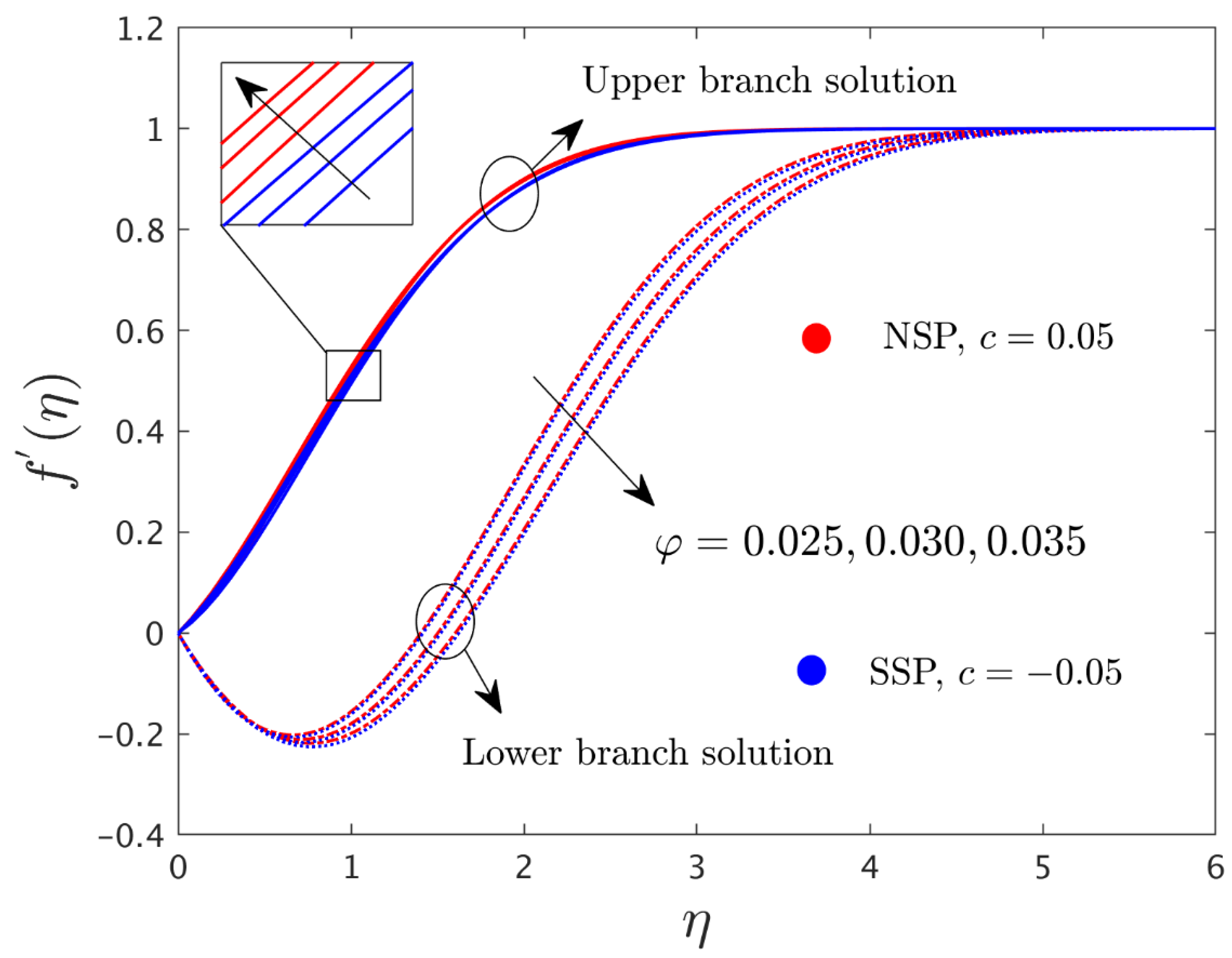
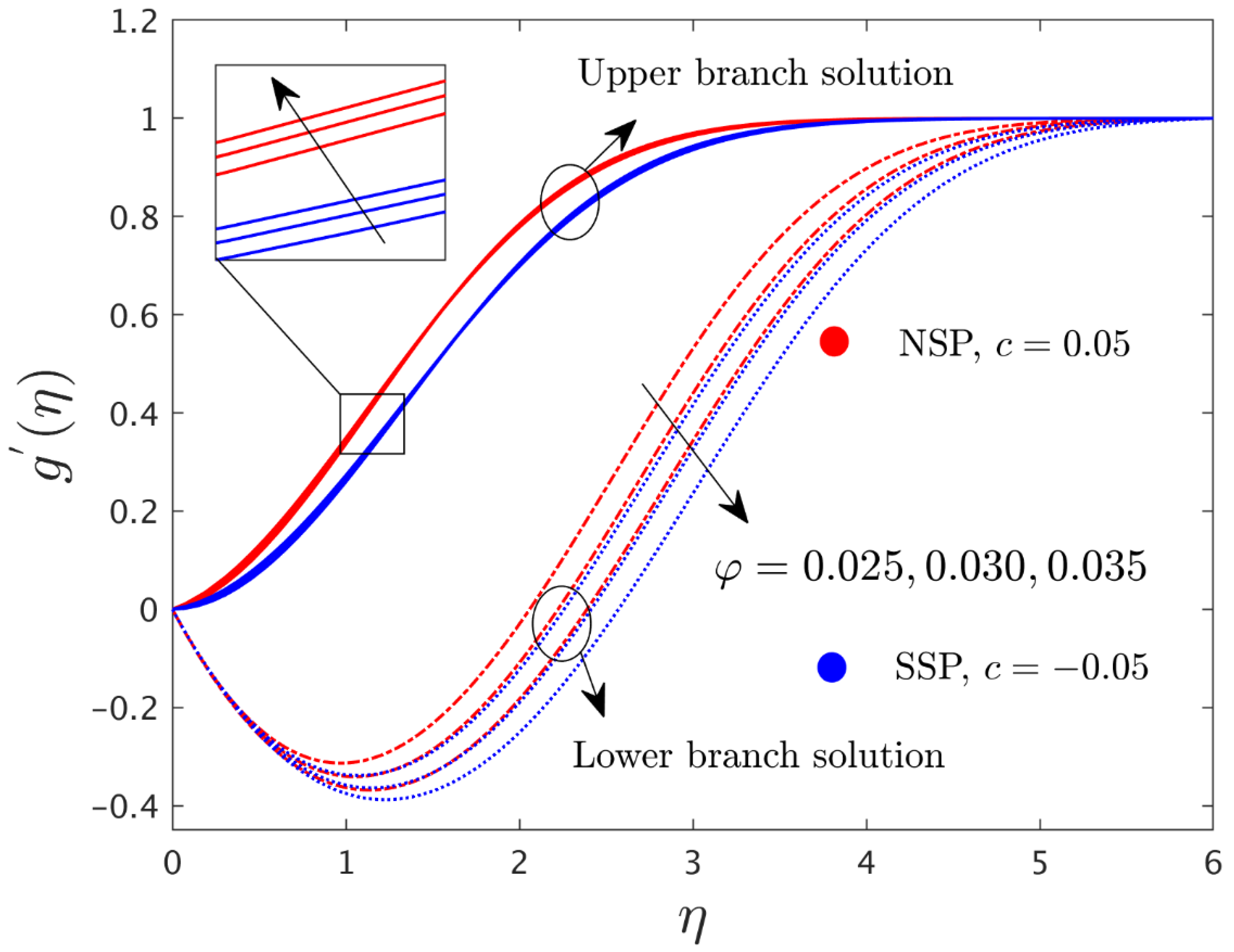
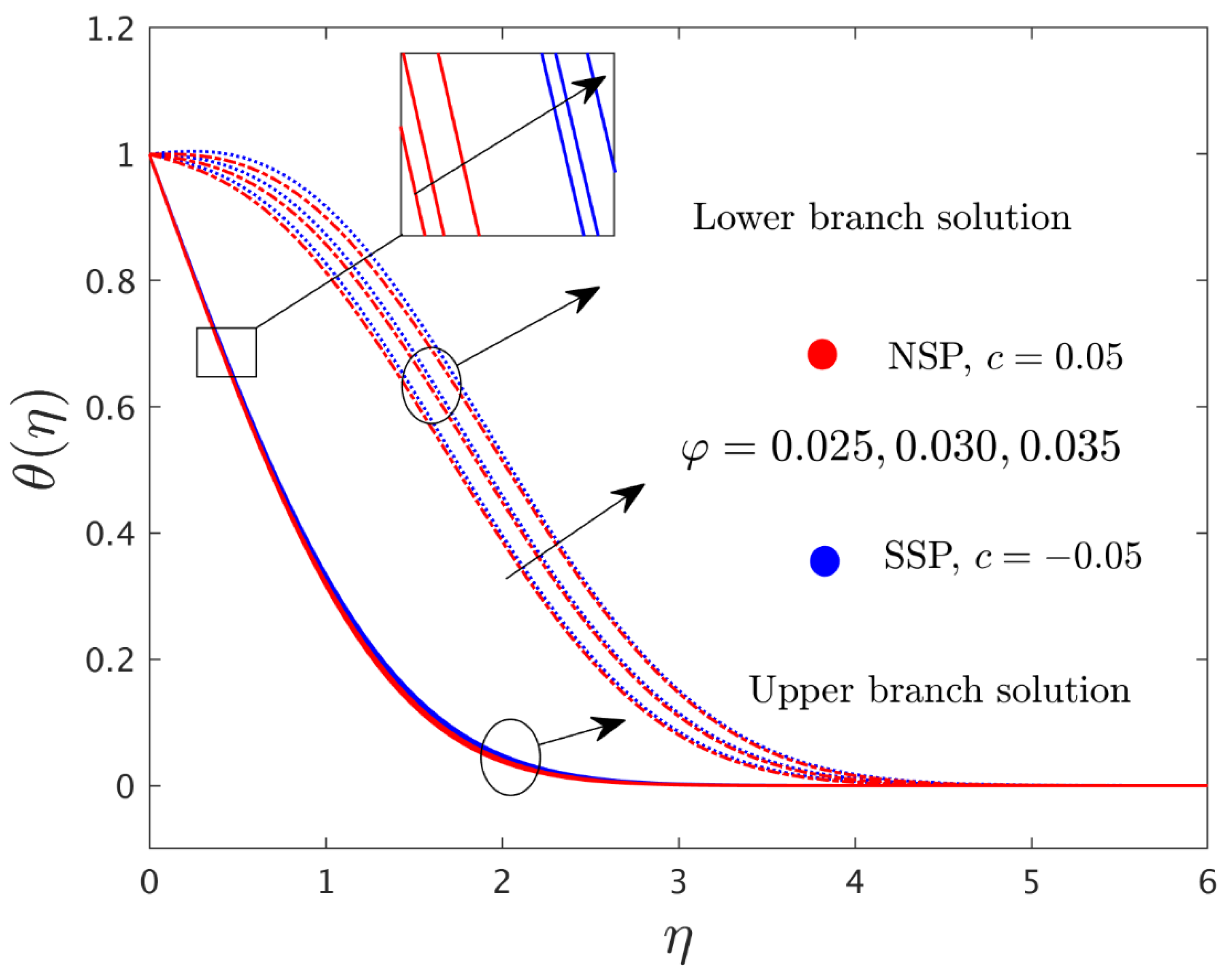
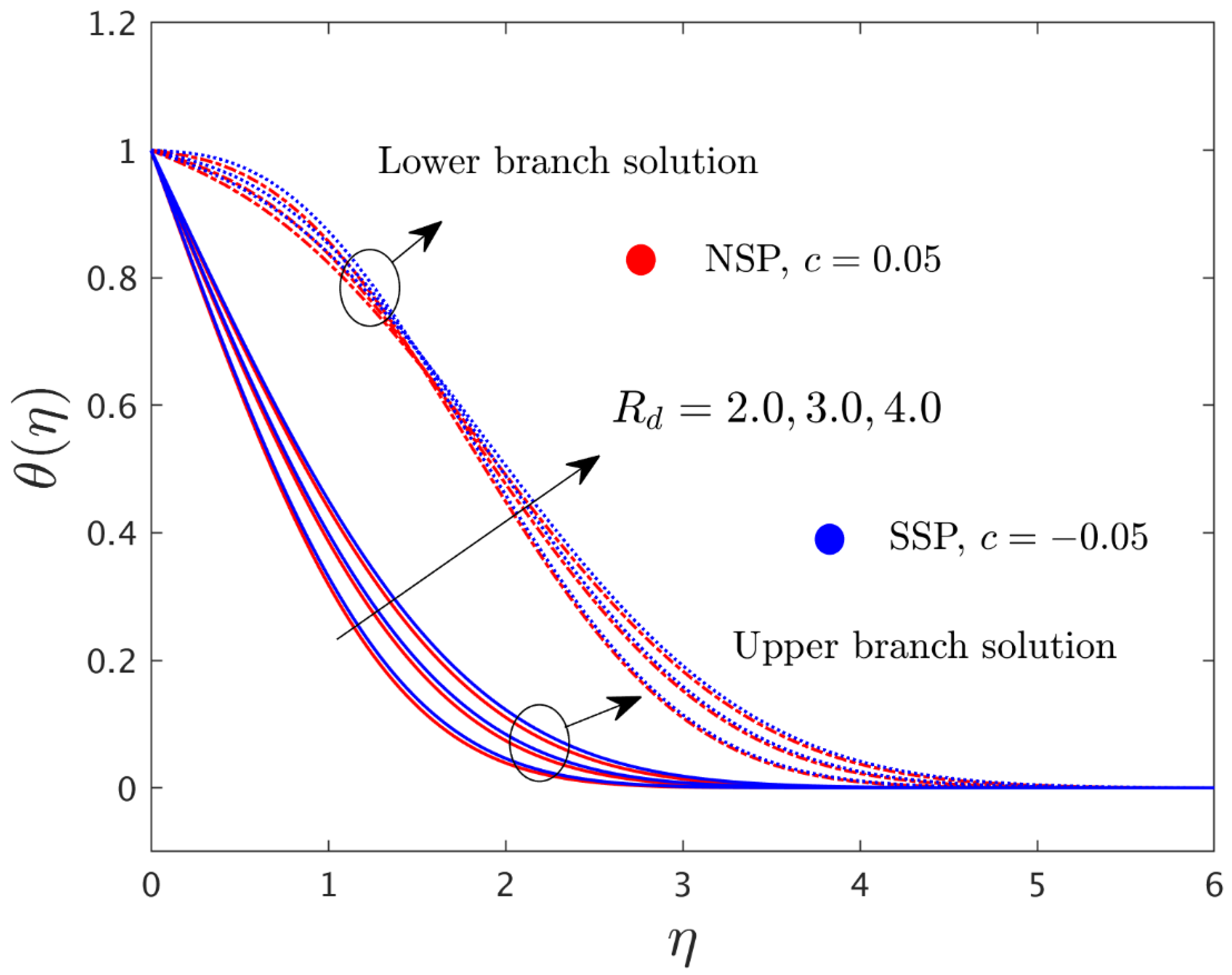
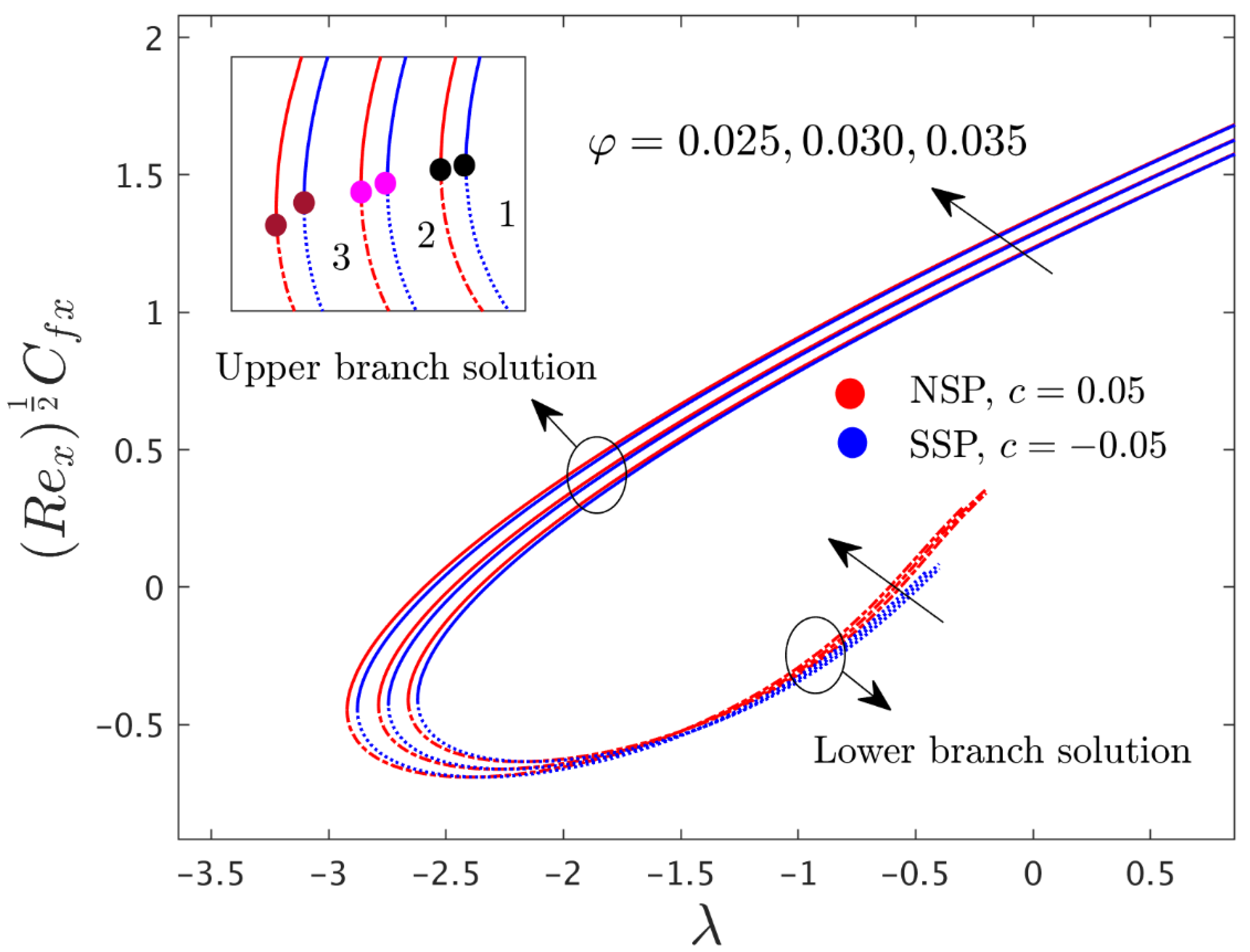
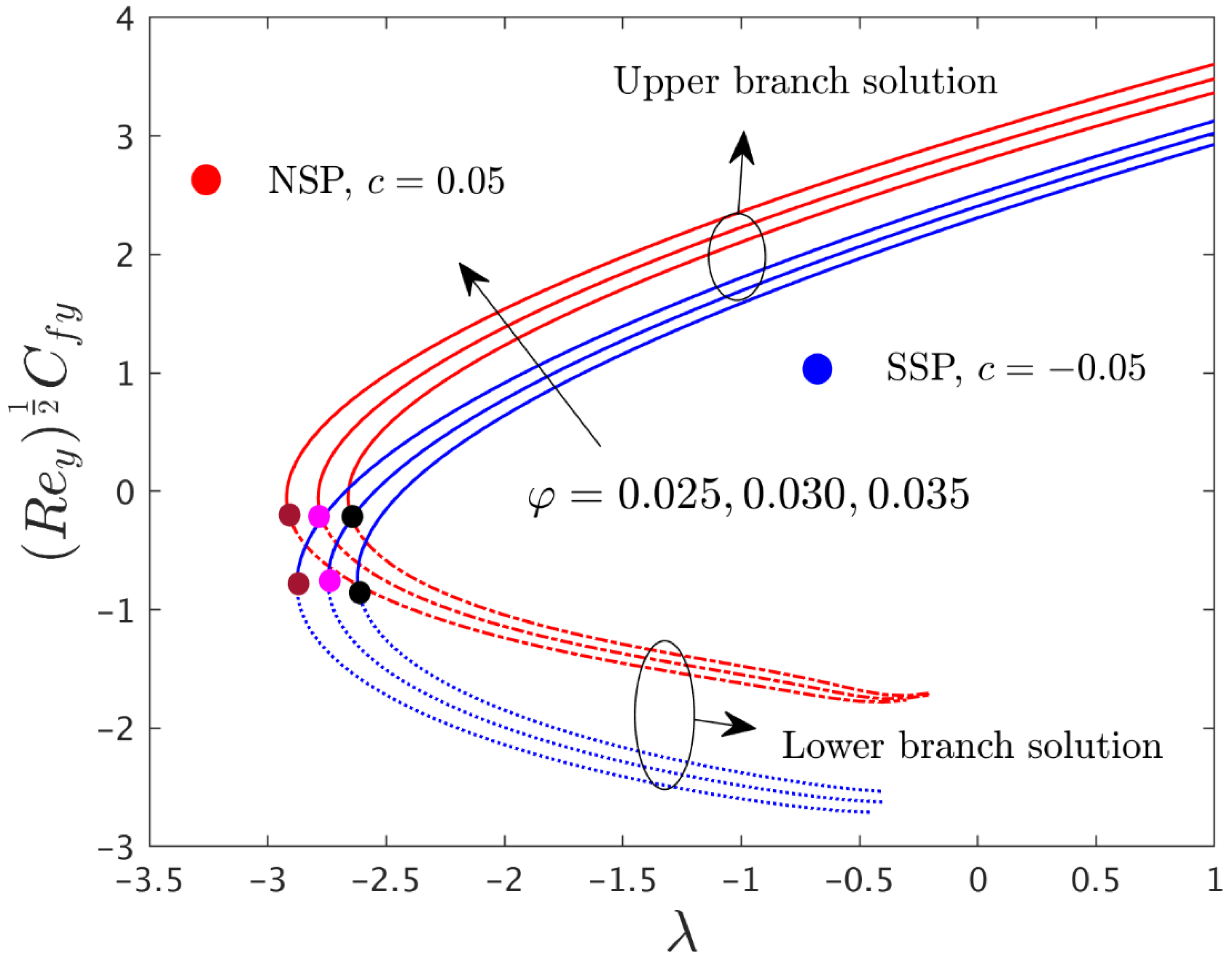
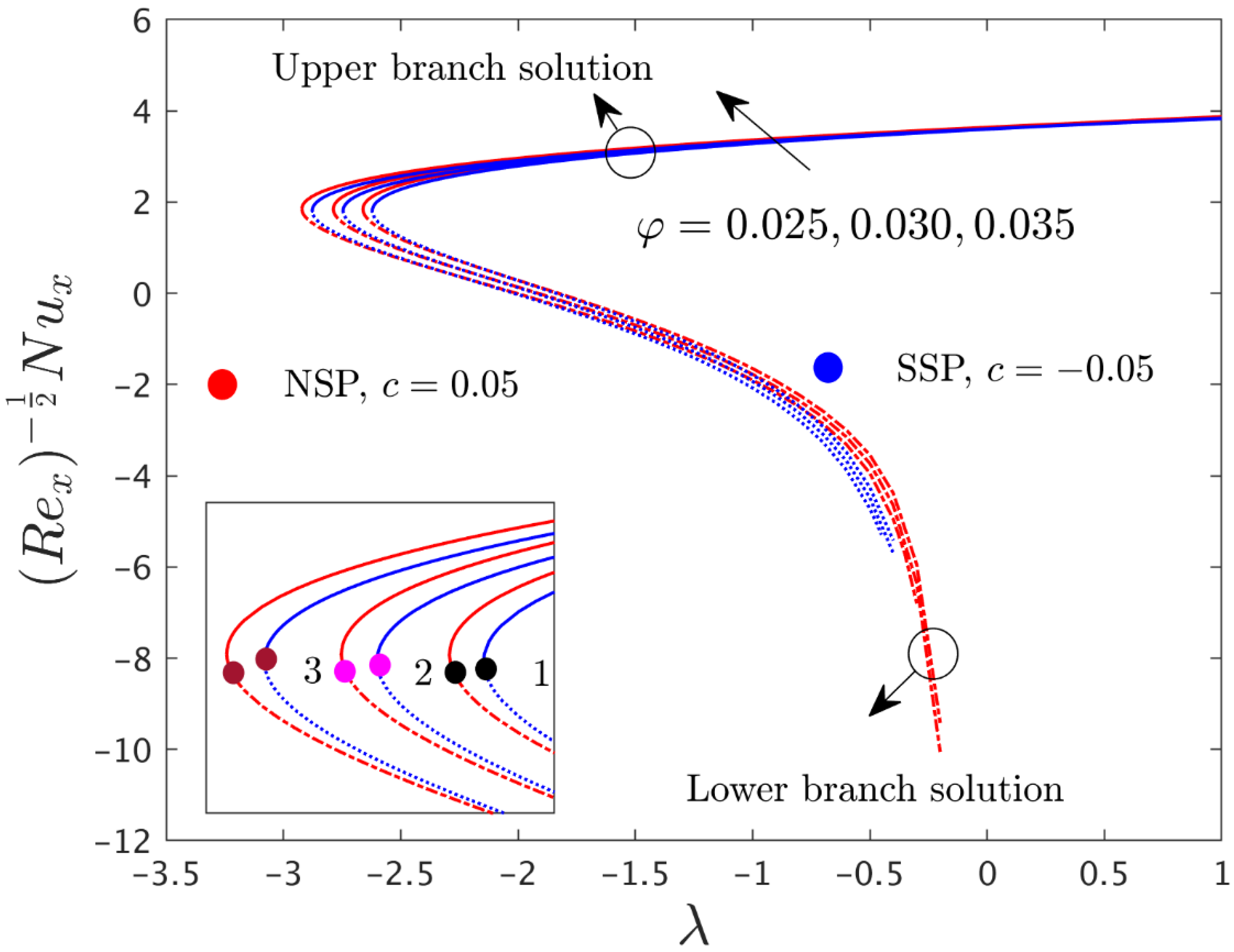
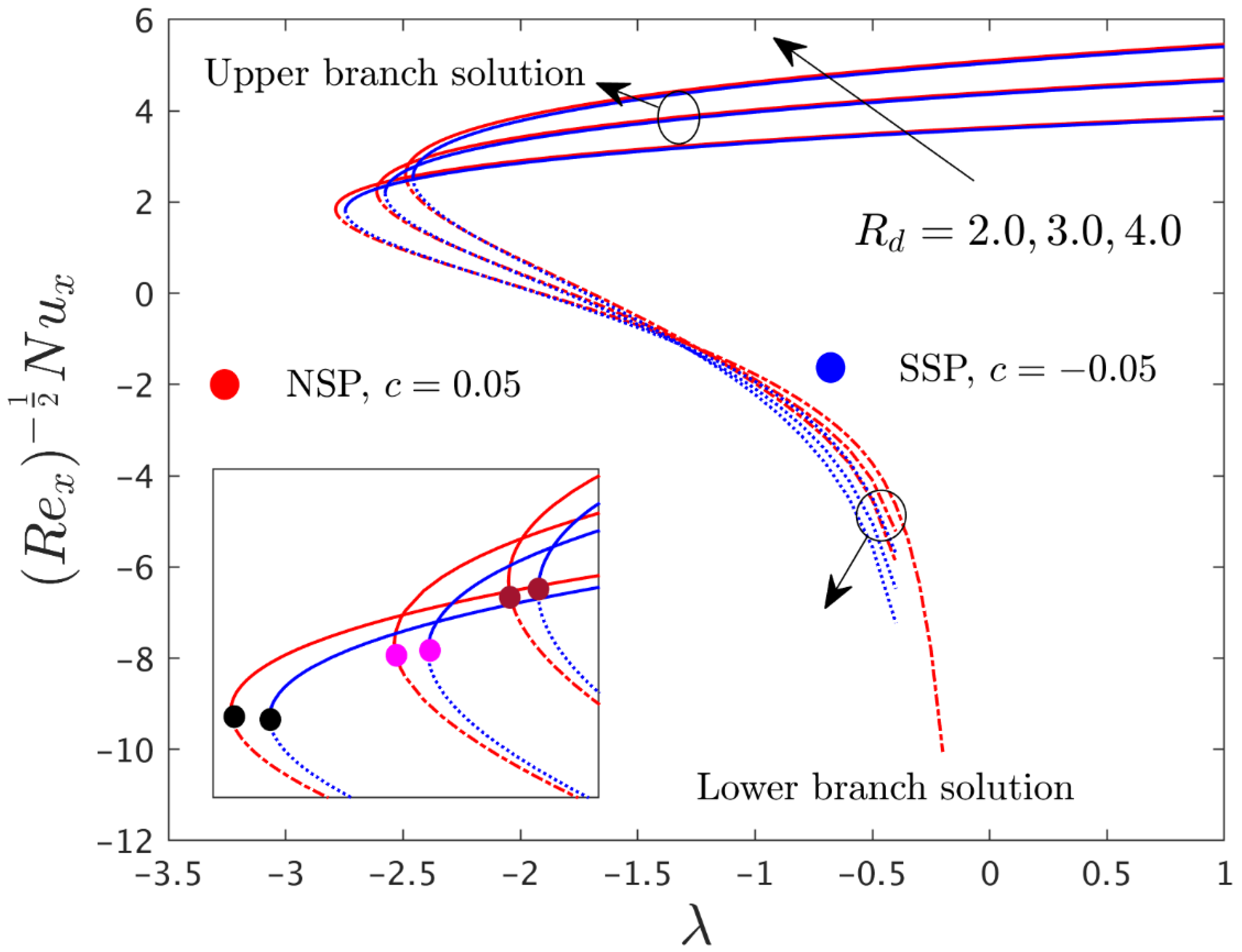

| Properties | Pr | ||||
|---|---|---|---|---|---|
| Water | 4179 | 997.1 | 21 | 0.613 | 6.2 |
| GO | 717 | 1800 | 5000 | - |
| Dinarvand et al. [31] | Bhattacharyya and Gupta [32] | Present Results | |||||
|---|---|---|---|---|---|---|---|
| Error% | Error% | ||||||
| 1.2681 | 1.2325 | 1.267911 | 1.231289 | 1.2681657 | 0.0063 | 1.2325853 | 0.0085 |
| Dinarvand et al. [31] | Bhattacharyya and Gupta [32] | Present Results | |||||
|---|---|---|---|---|---|---|---|
| Error% | Error% | ||||||
| 0.49930 | 0.05576 | 0.499358 | 0.055751 | 0.4993267 | 0.0023 | 0.0557624 | 0.0002 |
Publisher’s Note: MDPI stays neutral with regard to jurisdictional claims in published maps and institutional affiliations. |
© 2022 by the authors. Licensee MDPI, Basel, Switzerland. This article is an open access article distributed under the terms and conditions of the Creative Commons Attribution (CC BY) license (https://creativecommons.org/licenses/by/4.0/).
Share and Cite
Khan, U.; Zaib, A.; Ishak, A.; Waini, I.; Pop, I. Mixed Convection Flow of Water Conveying Graphene Oxide Nanoparticles over a Vertical Plate Experiencing the Impacts of Thermal Radiation. Mathematics 2022, 10, 2833. https://doi.org/10.3390/math10162833
Khan U, Zaib A, Ishak A, Waini I, Pop I. Mixed Convection Flow of Water Conveying Graphene Oxide Nanoparticles over a Vertical Plate Experiencing the Impacts of Thermal Radiation. Mathematics. 2022; 10(16):2833. https://doi.org/10.3390/math10162833
Chicago/Turabian StyleKhan, Umair, Aurang Zaib, Anuar Ishak, Iskandar Waini, and Ioan Pop. 2022. "Mixed Convection Flow of Water Conveying Graphene Oxide Nanoparticles over a Vertical Plate Experiencing the Impacts of Thermal Radiation" Mathematics 10, no. 16: 2833. https://doi.org/10.3390/math10162833
APA StyleKhan, U., Zaib, A., Ishak, A., Waini, I., & Pop, I. (2022). Mixed Convection Flow of Water Conveying Graphene Oxide Nanoparticles over a Vertical Plate Experiencing the Impacts of Thermal Radiation. Mathematics, 10(16), 2833. https://doi.org/10.3390/math10162833








